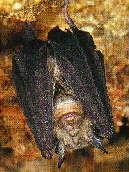|
Large-eared Horseshoe-bat

Photo: C & D Frith
Australia's Cape York Peninsula
Large-eared Horseshoe-bat: Rhinolophus
philippinensis
This is an insectivorous bat.
It has an elaborate nose-leaf, the U-shaped
lower part looking like a horseshoe.
-
It has long ears, is grey-brown above, and
slightly lighter below.
-
This small bat weighs only10-12g, has a head and body length of 62-65mm, tail
length of 33-35mm and forearm length of 50-53mm.
Habitat and
Distribution:
Lives in small caves and disused mines,
preferably in warm, humid areas for daytime roosting, a factor that limits their
distribution (in north-eastern Queensland).
It likes areas of dense vegetation such as
closed canopy vine forest that allows only a little light through. It has also been seen
feeding in open forest areas of Cape York Peninsula.
-
It is rare in Australia, but common in the Philippines, Kei Islands, Celebes, New
Guinea and Timor.
Diet:
Social Behaviour:
This bat does not seem to form large colonies. Scattered
individuals are found in caves, often in association with the Eastern Horseshoe-bat (a
close relative).
It hangs from the ceiling (not against the wall as most species
do) and only forms clusters when juveniles and young are left together while the adults
are feeding.
Additional Information:
- Its flight is similar to that of a butterfly due to its short broad wings. It
hovers and darts among the foliage and close to the surface of water.
- If by accident it lands in water, it can take off directly from the surface as
long as the fur has not become waterlogged.
- It has a very intense ultrasonic call, its pattern of cries consisting of long
constant-frequency portions with a short modulated termination. The call is snorted
through its nostrils and beamed directionally by the nose-leaf. This is an advantage as if
the bat is flying through dense vegetation and eating a moth at the same time, it is still
able to make its call. (Most other bats emit their calls through their mouth.)
- It has large ears that move rhythmically but separately from a forward-pointing
to a lateral direction. This sweeping motion is thought to increase the accuracy of its
echolation and is often observed as one approaches a resting bat.
|
